A company's success depends on many factors, but one of the most important is its ability to track and assess its progress towards key objectives. This process begins with the identification of key performance indicators (KPIs).

Most businesses have some sort of performance metric that they track, whether it's sales figures, conversion rates, or customer satisfaction scores. But sometimes, these standard KPIs just aren't enough to give you a true picture of how your business is doing. That's why it's important to supplement your KPIs with business-specific metrics that can give you a more complete picture of your performance.
That's where custom KPIs come in. With custom KPIs, it would be possible to accurately track the company's performance and identify areas for improvement. Without it, a company runs the risk of making decisions based on insufficient data. The development of custom KPIs is, therefore, an essential part of any business's operations.
What are Custom KPIs?
A lot of businesses these days are very metrics-driven. But what are metrics, really? Metrics are basically just numbers that give you an indication of how well your business is doing. This can be anything from the number of sales you make in a day to the number of visitors to your website.
Custom KPIs are simply Key Performance Indicators that you have designed yourself to track the specific performance indicators that are most important to your company.
For example, if you are a web design company, you might want to track the number of new clients you get each month or the average time it takes to complete a project.
If you're a retailer, tracking inventory levels and turnover rates can help you identify areas where you need to improve your operations.
If you're a service business, tracking customer satisfaction scores can help you pinpoint areas where you need to make changes.
These are just some scenarios when custom KPIs are useful. By tracking these custom KPIs, you can get a much better sense of how well your business is doing and where you need to make improvements.
For more information on standard KPIs, read our article on what is KPI in marketing and how to use it.
Why You Need Custom KPIs
As any business owner knows, Custom KPIs and custom metrics can be a powerful tool for tracking and improving performance. But what are the benefits of using Custom KPIs?
Here are just a few:
1. Custom KPIs can be tailored to your specific business goals.
Nobody knows your business as you do, so why rely on generic KPIs that don't really tell you anything useful? Custom KPIs are tailored specifically to your business goals, ensuring that you always have your finger on the pulse of what's important.
By taking the time to develop custom KPIs, you can avoid the "one size fits all" approach and ensure that you're always focused on what's most important to your business.
In today's competitive market, that's a priceless advantage. So if you're serious about taking your business to the next level, make sure you invest in custom KPIs. It's the best way to ensure that you're always moving in the right direction.

2. Custom KPIs can provide real-time data.
As any manager knows, data is essential for making informed decisions. But in today's fast-paced business world, data can quickly become outdated. That's where Custom KPIs come in.
By providing real-time data, Custom KPIs can help managers keep track of their business goals and make timely adjustments to their strategies. In addition, Custom KPIs can be customized to track specific metrics that are relevant to a company's business goals.
As a result, they provide a valuable tool for managers who want to make data-driven decisions.
3. Custom KPIs can help you identify areas of improvement.
Sometimes, the standard KPIs that organizations track don't really tell the whole story. That's where Custom KPIs come in—they can be tailored to provide a more accurate picture of what's really going on.
For example, let's say an organization is tracking the number of customer complaints as a KPI. But what if they're not also tracking the number of customer compliments?
Custom KPIs can help fill in the gaps and give you a more complete picture of your organization's performance. In other words, they can help you identify areas of improvement that you might otherwise miss. So if you're looking to get a more holistic view of your organization's performance, consider customizing your KPIs. It just might give you the insights you need to take your business to the next level.
4. Custom KPIs can help you track progress towards realistic business targets.
Whether you're a startup entrepreneur or a Fortune 500 CEO, setting and achieving business goals is essential to success. But how can you be sure you're making progress towards your targets? And realistic targets at that?
The goals of a small business and a Fortune 500 company vary by a wide margin, so it wouldn't be smart to use the same metrics for both, right? Customizing your KPIs allows you to set realistic targets that accurately reflect the unique challenges and opportunities of your business.
5. Custom KPIs can help you benchmark your performance against other businesses in your industry.
If you're looking to benchmark your performance against other businesses in your industry, custom KPIs are a great way to do it. Unlike generic KPIs that don't take your specific industry into account, creating your own KPIs based on what your industry dictates can help you benchmark your performance against other businesses in the same line of business. As such, you can get a clear picture of how you're doing in comparison to your competitors.
For example, let's say you're a manufacturer. You might want to track KPIs like production volume, on-time delivery rate, and customer satisfaction. By monitoring these KPIs, you can get a good sense of how your business is performing relative to other manufacturers.
And if you see that you're lagging behind in one or more of these areas, you can take steps to improve your performance. So if you're looking to benchmark your business against others in your industry, custom KPIs are a great way to do it.

6. Custom KPIs are flexible.
Custom KPIs are the best kind of KPIs. Why? Because they're flexible! Unlike some other business measurement tools, custom KPIs can be easily adapted as your business evolves. This makes them an essential tool for businesses of all sizes.
These are great especially since digital marketing is consistently evolving. A few years ago, you wouldn't even dream of using short video clips to promote your products, but now you can do that with TikTok advertising! As such, you have to adjust your marketing metrics to engagement, viewing time, and more.
With custom metrics, you can choose exactly what you want to measure, and how you want to measure it. Need to track progress on a specific project? No problem! Want to see how well your team is working together? Custom KPIs can help with that too. In short, custom KPIs are the most versatile type of KPI. And that's why they're the best.
7. Custom metrics can help you find hidden opportunities.
As a business owner, you're always on the lookout for hidden opportunities. But sometimes, those opportunities can be hidden in plain sight—in your data.
Most people are familiar with the standard metrics that are used to measure website performance, such as page views, unique visitors, and time on site. However, these metrics only tell part of the story.
Custom metrics can help you uncover hidden trends and patterns in your data, providing valuable insights that can help you take your business to the next level. They can help you to uncover hidden opportunities and get a more complete picture of how your website is being used.
***
Ultimately, using Custom KPIs is a smart way to run your business. The only problem you would encounter with using Custom KPIs is that not all analytics and business management platforms have this feature, especially advertising platforms.
If you plan on using custom KPIs for your online ads, you would have to partner with a platform that allows custom metrics like Brax. The platform allows its users to create custom conversion metrics that will accurately reflect the goals of the business.
Brax is an essential tool for any business looking to make native advertising and social media advertising work for them. With Brax, you can create high-performing campaigns that reach your target audience and achieve your objectives. If you'd like to know more about how it works, book a free demo of Brax today, no strings attached!
How to Set Up Custom Metrics in Brax
Most businesses today are data-driven, and Brax is no different. As a business intelligence tool, Brax provides users with the ability to create custom KPIs. This allows businesses to track the KPIs that are most important to them and makes it easy to see how they are performing over time.
Setting up custom KPIs in Brax is quick and easy, and this guide will walk you through the process.
Step 1: Identify the base metrics
Creating custom metrics can be a great way to track the performance of your business. But before you can create a custom metric, you first need to identify the metrics that will be the basis of the calculation.
This can be tricky, as there are a lot of different metrics out there. But with a little thought, you should be able to identify the key metrics that will help you track your business performance.
With that in mind, here are a few things to consider when choosing which metrics to use:
1. What information do you want to track?
2. How will this metric be calculated? (average, sum, percentage, rate, etc.)
3. What is the unit of measurement? For online businesses, it is usually based on a monetary value, the number of customers, value per customer, value per product, product per customer, speed of reordering, etc.
4. How often will you update this metric? Daily, weekly, monthly, quarterly, etc.
5. What is the goal or target value for this metric?
Once you've answered these questions, you'll be well on your way to creating custom metrics that can help you track and improve your performance.
For instance, you may want to track the conversion rate of users who viewed your offer page for more than 30 seconds. In this instance, the metrics you would need are:
- number of users who viewed your page for 30 seconds or more (X)
- number of users who signed up after staying on the page for 30 seconds or more (Y)
Since you will be looking for the conversion rate, this will be calculated as:
custom metric = Y/X * 100
Take note of how you will calculate the custom KPI as it will be important later on.
Keep in mind that if you don't know what you want to track and how to calculate it, this won't work.
Step 2: Create the Custom Metrics in Brax
Log in to your Brax account and navigate to the "Profile" section. When you click on your profile name at the top right corner, you'll see a list of all options. Choose "Metrics".

On the Metrics page, you will see two kinds of metrics: the Conversion Metrics and the Reporting Metrics. Conversion metrics track events, which is not what we'll be focusing on here. Click here to understand more about Conversion Metrics.
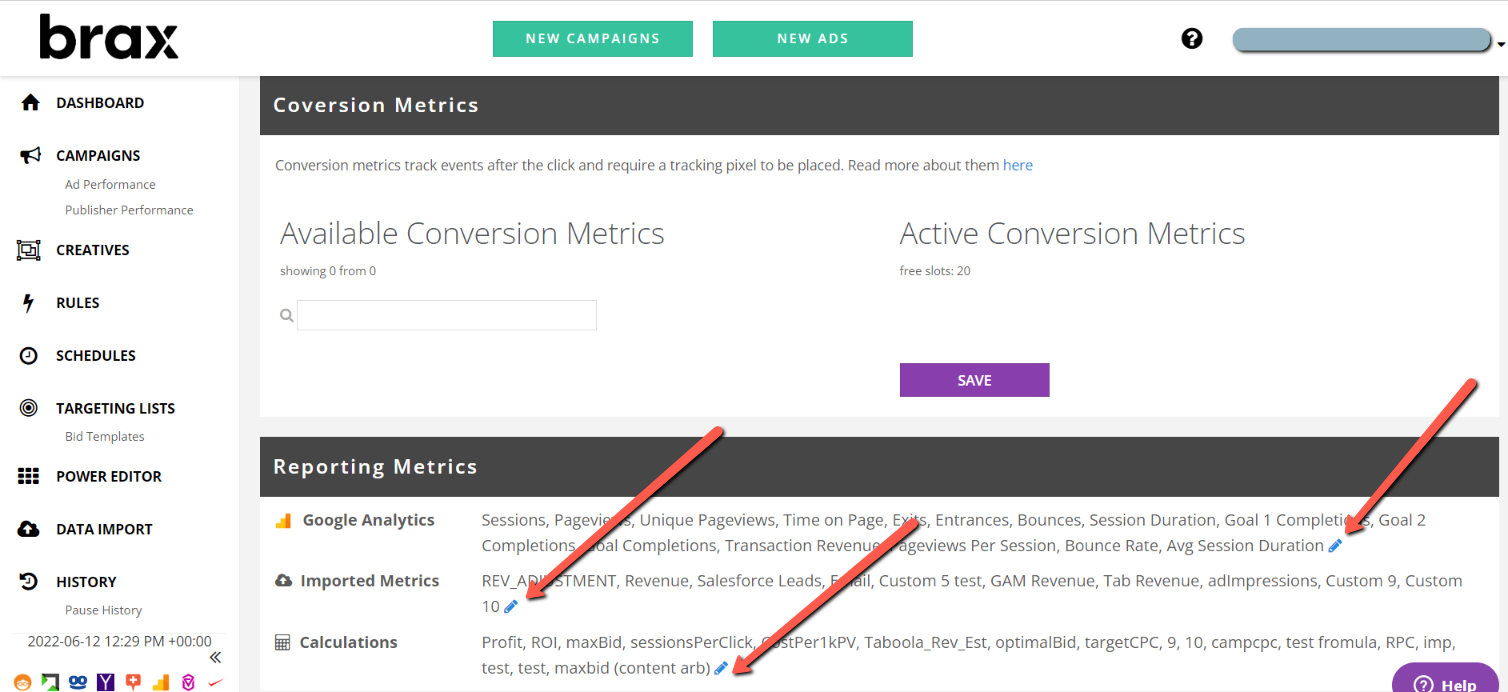
We'll be focusing on Reporting Metrics. There are three types of reporting metrics that you can use for your Custom KPI:
-
Google Analytics
Any marketer worth their salt knows that data is key to understanding your audience and crafting successful campaigns. Google Analytics is a powerful tool that can provide a wealth of insights into your website traffic.
However, anyone who has ever dabbled in Google Analytics knows that it can be a bit of a headache trying to decipher all of the data. What do all of these numbers mean?
Fortunately, Brax makes it easy to add custom metrics that can help make sense of it all. You add the metrics to your specific needs, which makes it much easier to track your progress and identify areas for improvement.
There's no need to add calculated metrics here because all you have to do with this one is choose from a list.
If the default GA reports are not enough, do the following:
- Click on the edit icon (pencil icon) for Google Analytics
- Click on the New Metric button in the upper right corner
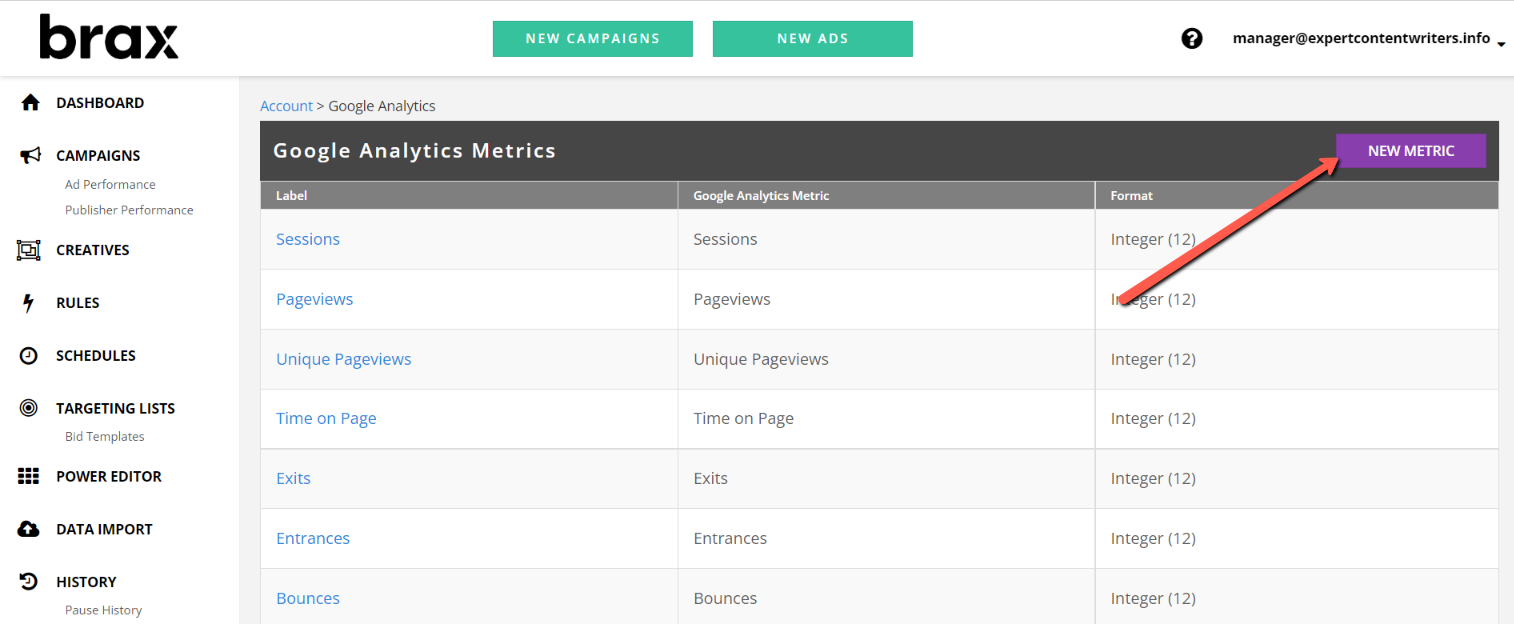
- Choose the metric from the extensive dropdown list
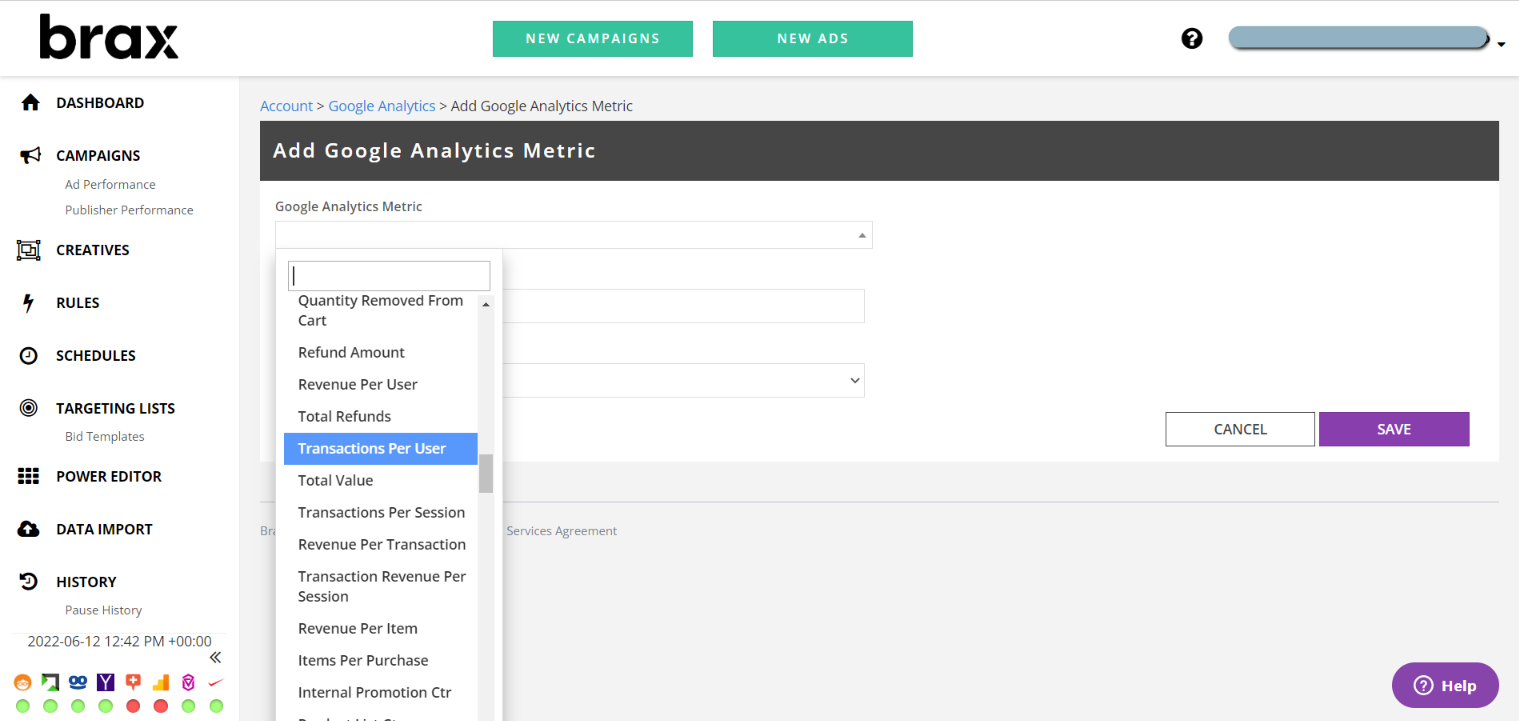
- Name the metric to help you identify it on reports
- Choose the number format (integer, decimal, currency, percentage, and time).
That's it for Google Analytics. Make sure you link your Google Analytics to Brax to make this work.
-
Imported Metrics
If you're like most people, you probably have a love/hate relationship with data. On the one hand, it's essential for understanding how your business is performing. On the other hand, it can be tedious and time-consuming to gather and analyze.
Fortunately, Brax makes it easy to import data and create custom metrics that can be used in reporting and rules. With just a few clicks, you can bring in data from external sources and start tracking the key indicators that matter to you.
To do this, follow these steps:
- Click on the edit icon (pencil icon) for Imported Metrics
- On the Imported Metrics page, add or edit the list of metrics that you plan on uploading. Label them as you see fit and don't forget to adjust the corresponding formats.
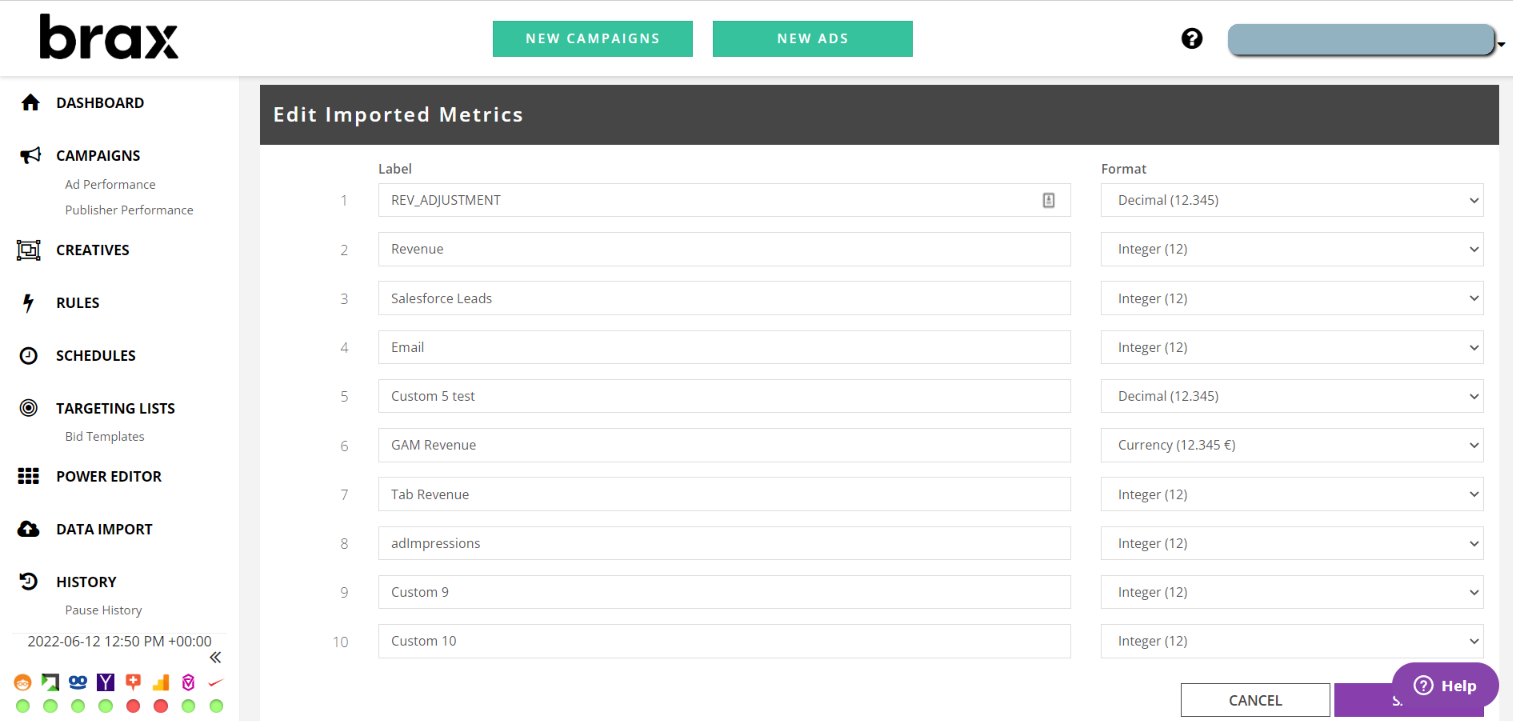
- Click on Save then navigate to the Data Imports page (you can find this option on the left pane).
- Export the template (this template will be based on what you placed on the Imported Metrics page), then place the data you want to add on this file.
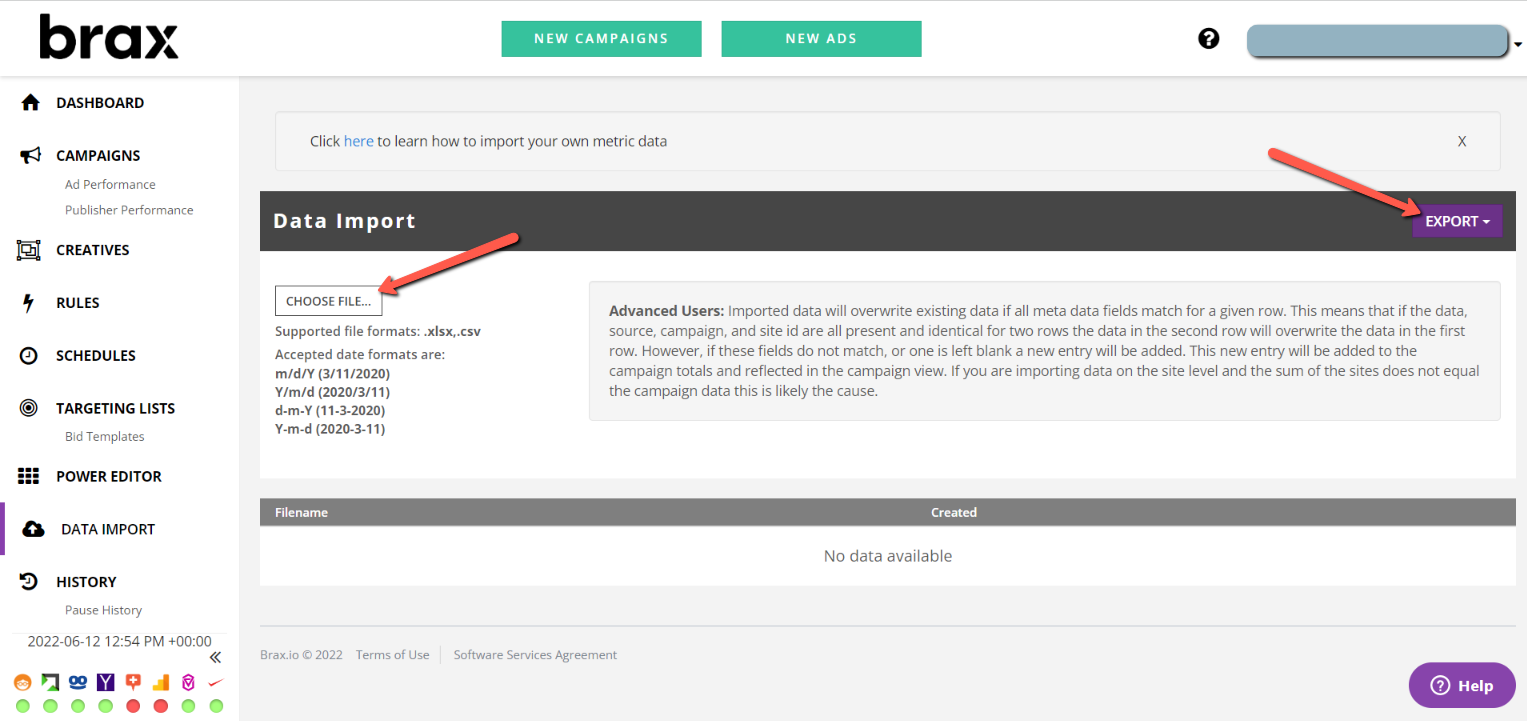
- Upload the file.
And that's it! You can expect to see these custom metrics on your campaign reports.
-
Calculations
In business, numbers are everything. Without accurate data, it's impossible to make informed decisions about where to allocate resources or how to measure success. That's why Brax places such a high value on calculated metrics. By understanding the numbers behind your business's performance, you can make smart choices that drive growth and profitability.
But what exactly are calculated metrics? In essence, they are numerical values that are derived from other data points.
For example, you might calculate your customer churn rate by dividing the number of customers you lose each month by your total number of customers. This gives you a percentage that can be used to compare your performance over time or against other businesses in your industry.
Brax provides a wide range of calculated metrics that can be used to track and improve your business performance. From customer lifetime value and conversion rates to social media engagement and website traffic, we have the data you need to make better decisions and achieve your goals.
How exactly do you set it up? Follow these steps:
- Click on the edit icon (pencil icon) for Calculation.
- You will arrive at the Calculated Metrics, where you will see formulas of already created calculated metrics, as well as the format of the output. Click on the New Metric button if none of the default metrics matches your needs.
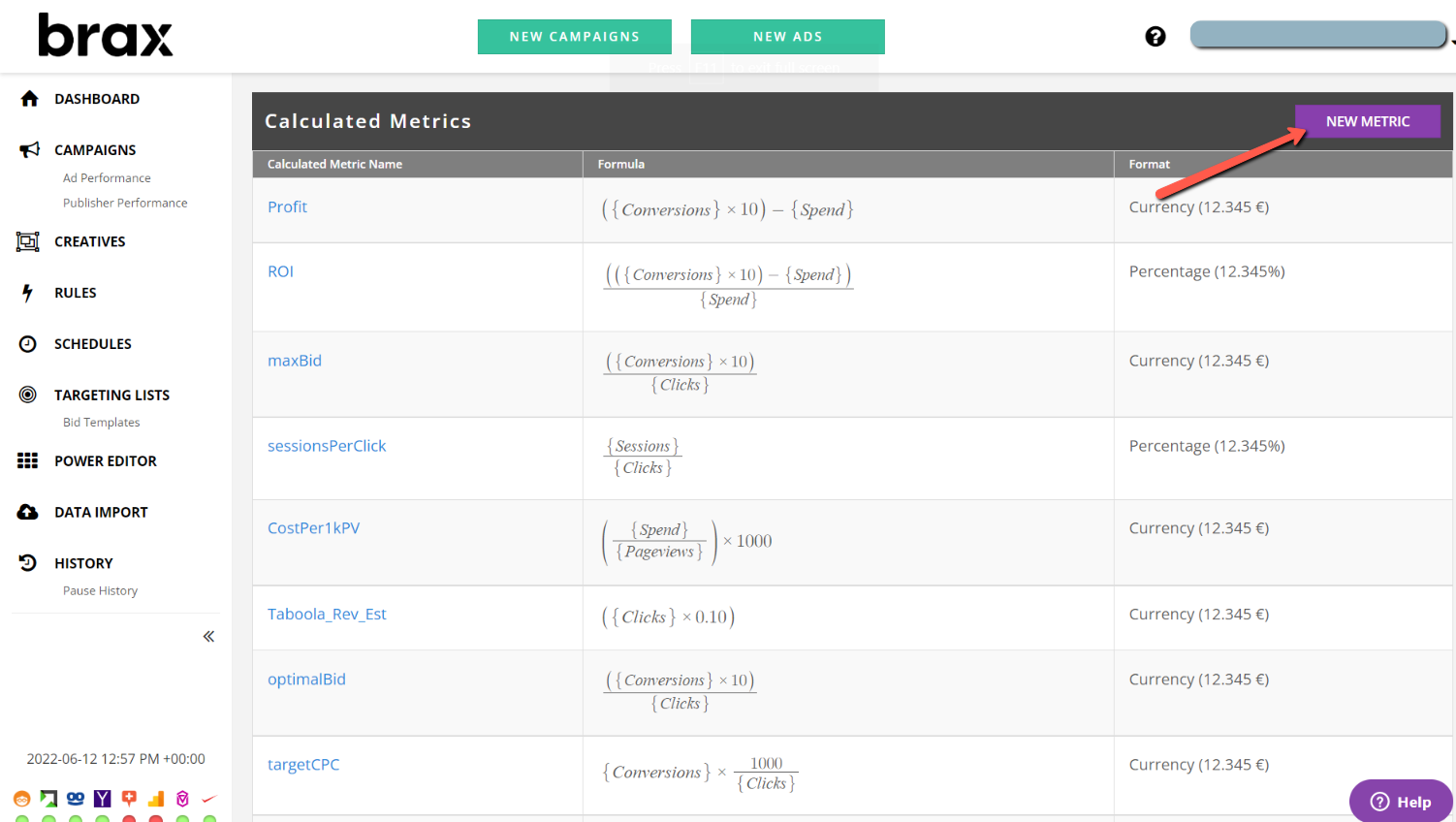
- Input the label, format, and formula of the custom metric you want to add. For the formula, choose from any of the standard metrics listed down and select the calculation (use the small calculator for this). You can also use imported metrics here, provided that you have already created them.
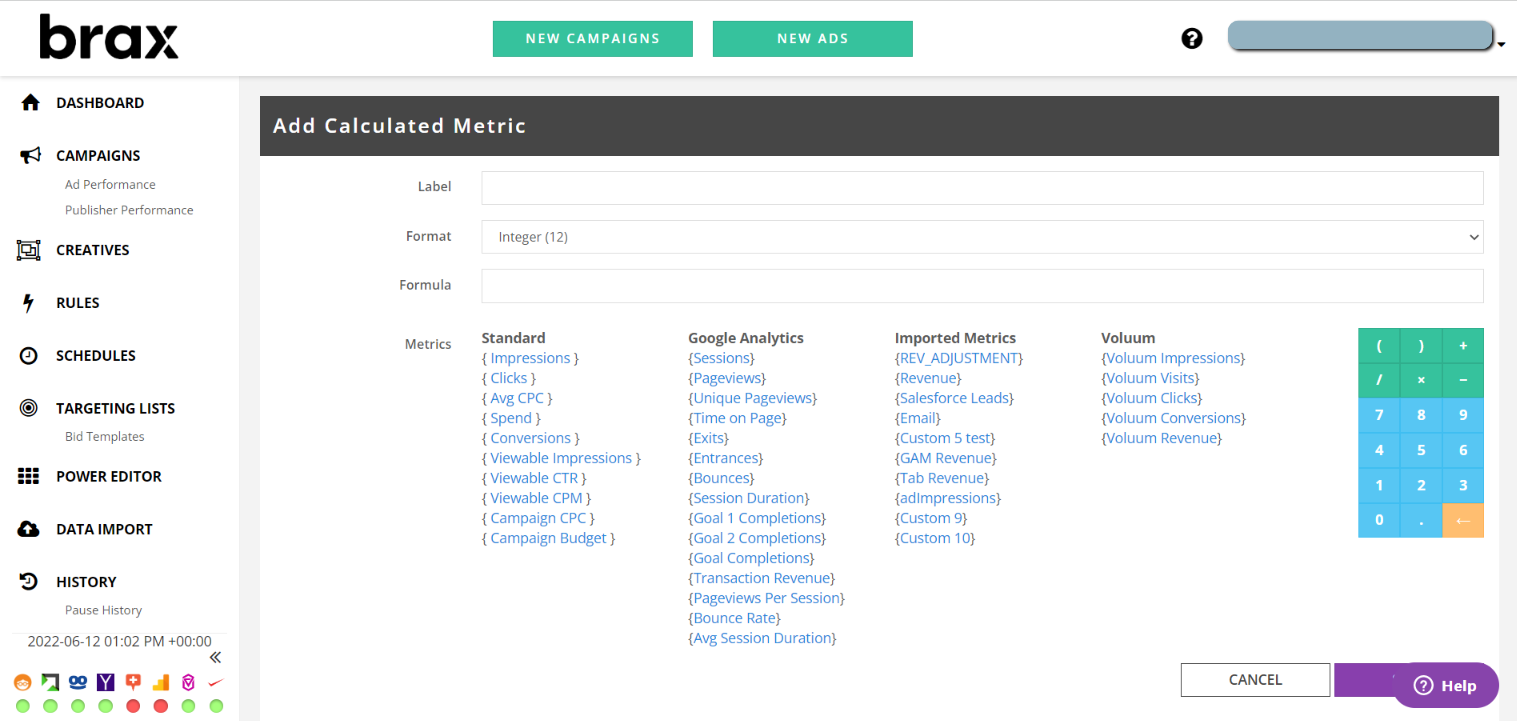
- Click on Save. You will immediately find your new custom KPI at the bottom of the list of Calculated Metrics. It will automatically be added to your reporting columns (usually in the right-most column).
Say for example you wanted to calculate the Average Revenue for every Unique Pageview you get so that in the future, you know how many unique page views you should drive to your website to earn a target revenue.
You can set it up as follows:
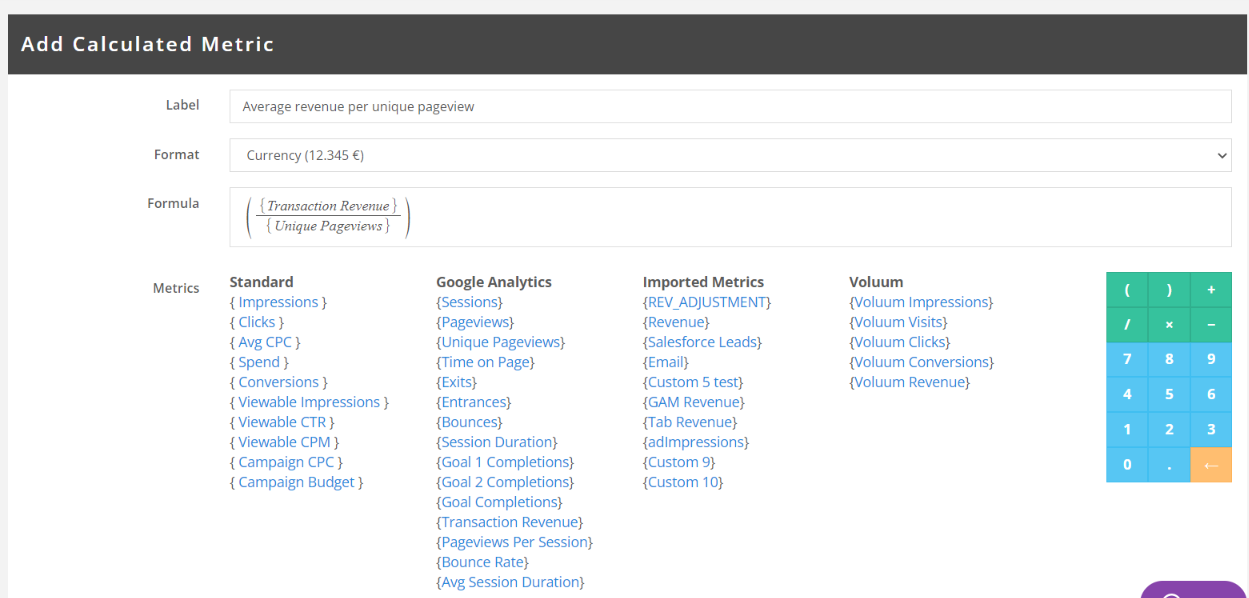
The standard metrics you can use for calculated metrics are:
{ Impressions }
{ Clicks }
{ Avg CPC }
{ Spend }
{ Conversions }
{ Viewable Impressions }
{ Viewable CTR }
{ Viewable CPM }
{ Campaign CPC }
{ Campaign Budget }
However, you can add so much more by configuring your Google Analytics metrics and the Imported metrics.
The Bottom Line
There's no denying that KPIs are an essential part of any business, large or small. Without KPIs, it would be nearly impossible to accurately assess your company's performance or make informed decisions about where to allocate resources. In other words, KPIs are a necessary evil.
But that doesn't mean that all KPIs and metrics are created equal. In fact, one of the biggest mistakes businesses make is using generic, off-the-shelf KPIs that don't really align with their specific goals and objectives.
It can be tempting to rely on standard KPIs, but doing so could cause you to miss important details about your business' performance. Customizing your KPIs is essential for getting an accurate picture of how your company is really doing.
By tailoring your metrics to your specific needs, you can ensure that they're actually providing valuable insights into your business. So if you're not using custom KPIs already, now is the time to start. Trust us, your business will thank you for it!
If you have any questions about setting up custom calculated metrics in Brax, don't hesitate to reach out to us by filling out the contact form below or sending us an email. Our team of expert ad managers will respond to you at the soonest possible time. And don't forget to sign-up for a free trial today!
Liked this article? You might want to check these out, too:
- Step-by-Step Guide to Brax Rules for E-Commerce and Content Publishers
- How to Optimize Native Ad Campaigns for More Revenue using Brax
- 17 Best Social Listening Tools That You Can Start Using Today!
- 7 Tips to Attracting the Perfect Customer
- Creative Real Estate Ads that Let You Close Fast and How to Make Them!

